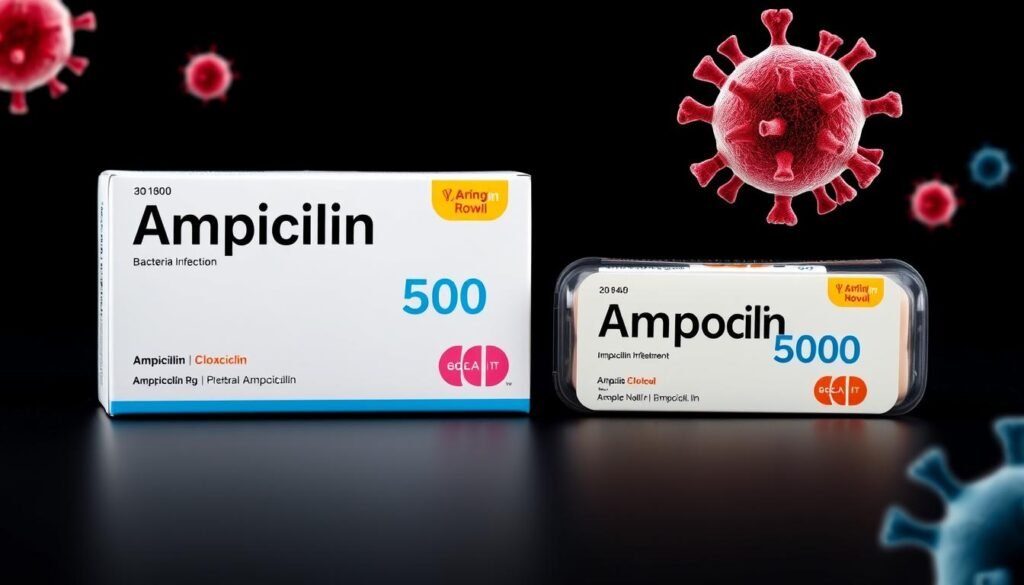Ampicillin and cloxacillin are important antibiotics. They fight bacterial infections. These medicines have been used for many years.
When used together, ampicillin and cloxacillin work well against some infections.
This guide covers how to use ampicillin and cloxacillin. It’s for doctors and patients. Knowing how to use these antibiotics is key for good treatment.
Introduction to Ampicillin and Cloxacillin
Ampicillin and cloxacillin are two important antibiotics. They are used to fight many bacterial infections. These medicines are part of the beta-lactam family, which comes from penicillin. Knowing how these antibiotics work is key for doctors and patients.
What are Ampicillin and Cloxacillin?
Ampicillin and cloxacillin are like penicillin but different. They stop bacteria from making their cell walls. But they work in different ways:
- Ampicillin fights many kinds of bacteria.
- Cloxacillin is made to fight bacteria that penicillin can’t.

How do they work?
Ampicillin and cloxacillin stop bacteria from making their cell walls. This makes the bacteria weak and they die. This is why these medicines are good at killing bacteria.
Here’s how they do it:
- They attach to proteins on the bacteria’s cell wall.
- This stops the bacteria from making a strong cell wall.
- Without a strong wall, the bacteria burst under pressure and die.
Knowing how ampicillin and cloxacillin work helps doctors choose the right medicine for infections.
Indications for Ampicillin and Cloxacillin
Ampicillin and cloxacillin are two antibiotics used to fight many bacterial infections. They work well against different kinds of bacteria. This makes them very useful for doctors to use.
Bacterial infections treated by Ampicillin and Cloxacillin
Ampicillin and cloxacillin help with several bacterial infections. Here are some examples:
- Respiratory infections: These antibiotics are good for infections in the lungs, like pneumonia. They work well against Streptococcus and Haemophilus influenzae, common lung infection causes.
- Urinary tract infections (UTIs): Ampicillin is often used for UTIs caused by Escherichia coli. It kills the bacteria, easing symptoms and preventing problems.
- Skin infections: Cloxacillin is great for skin infections caused by resistant staphylococci. Its special structure helps it fight off these tough bacteria.

When are these antibiotics prescribed?
Doctors give ampicillin and cloxacillin based on the infection type, how bad it is, and the patient’s health. They also check for allergies or things that shouldn’t mix with the medicine. Sometimes, they use these antibiotics to prevent infections, like before surgery.
Doctors think a lot before giving these antibiotics. They make sure they’re the right choice for the best results. Knowing when these antibiotics are used helps patients and doctors work together better.
Dosage and Administration
Ampicillin and cloxacillin can be given in different ways. This includes oral, intravenous, and intramuscular routes. The choice depends on the patient’s age, health, and the infection type.
The dosage for ampicillin and cloxacillin changes based on several things. These include the patient’s age, weight, kidney function, and the infection type. Doctors carefully pick the right dose for each patient.
For taking by mouth, ampicillin and cloxacillin come as capsules or suspensions. Adults might take 250 mg to 500 mg every 6 hours. Kids’ doses are based on their weight, usually 25 to 50 mg per kg per day, split into four doses.
When given through an IV, the doses are different. Adults might get 1 to 2 grams every 4 to 6 hours. Kids’ doses are based on their weight too.
Using an IV is needed for severe infections or when eating is hard. The dose for an IV is similar to the oral dose, with adjustments for the patient’s needs.
It’s important for patients to take all their antibiotics as directed. Even if they feel better, they should finish the treatment. Not taking all the medicine can lead to antibiotic resistance and treatment failure.
Precautions and Contraindications
Ampicillin and cloxacillin are good for fighting many bacterial infections. But, there are things to think about before taking them. It’s important to talk to your doctor about your health and any allergies you have.
Patients with allergies to penicillins
If you’re allergic to penicillins, be careful with ampicillin or cloxacillin. You might have a bad reaction, like anaphylaxis. Tell your doctor about any allergies you’ve had before. This helps them keep you safe.
Pregnant and nursing women
If you’re pregnant or nursing, talk to your doctor first. These antibiotics are usually safe, but they might not be best for everyone. Your doctor might suggest something else to protect your baby.
Patients with kidney or liver problems
If your kidneys or liver don’t work well, you might need special care with these antibiotics. They get removed from your body through your kidneys. If your kidneys aren’t working right, you could have too much of the drug. Your doctor will check your health and adjust the dose to keep you safe.